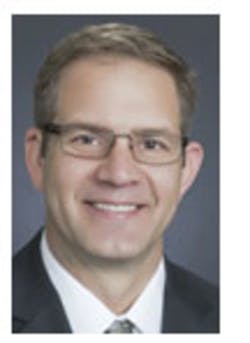Founded in 1957 as the Institute for Printed Circuits, IPC’s name has evolved along with the technologies that its member companies address. Today, the company retains its original initials but adds an identity statement to form its full name: IPC—Association Connecting Electronics Industries. While continuing to emphasize the importance of the circuit board, the global trade association also supports networking and technical exchange among its more than 3,300 member companies—which constitute an estimated $2.02 trillion global electronics industry in all facets of printed-circuit-board manufacturing and electronics assembly.
John W. Mitchell, D.Ed.
An association must be about its members, according to John W. Mitchell, D.Ed., president and CEO of IPC. Consequently, he has launched an initiative to focus on customer success. Mitchell’s appointment as IPC president and CEO was announced in March 2012. On Feb. 20, at his first IPC APEX EXPO since assuming his new role, he spoke with EE-Evaluation Engineering.
Mitchell began his engineering career at General Electric Aerospace and has held management positions at companies including Bose and Alpine Electronics of America. He also has previous international nonprofit experience, most recently serving as the CEO of Golden Key International Honour Society, a nonprofit collegiate honor society with more than 2 million members from more than 190 nations.
But it was his experience in the for-profit sector, he said, that drove home the importance of being able to demonstrate members’ success. In the for-profit world, Mitchell said, companies must take care of their customers if they want to keep those customers, and the same concept applies to IPC. In difficult economic times, he said, companies can be motivated to cut their association memberships. The goal of his customer-success initiative is to demonstrate to members that their IPC dues provide a very favorable return on investment—a claim for which he has anecdotal support. One member, he said, reported saving $2 million from information learned as a result of its IPC membership.
The initiative got its formal start last November when Mitchell and IPC hired Sanjay Huprikar as vice president of member success. Huprikar most recently was the executive director of customer success at LLamasoft, a supply-chain design software and technology solutions company. Huprikar, who earned engineering and business degrees, now is responsible for membership, member support, events, industry councils, and market research.
IPC serves its members as a source for industry standards, training, market research, and public policy advocacy. With respect to this last function, IPC recently announced the appointment of John Hasselmann as its new vice president of government relations. Hasselmann, based in IPC’s Washington, D.C., office, is responsible for development and implementation of the organization’s global advocacy efforts and policy agenda.
Mitchell noted that most IPC member companies do not have an office in D.C., but what happens in D.C. can drastically impact them. In contrast, big companies may have a D.C. presence but want to maintain a low profile on potentially controversial issues. For big companies, IPC’s Washington office can serve as a buffer, Mitchell said; for smaller companies, it can serve as a channel.
Mitchell cited two policy areas of concern: conflict minerals and ITAR (International Traffic in Arms Regulations). With respect to the latter, in January IPC filed regulatory comments commending the U.S. State Department for enumerating printed boards in proposed revisions to Category XI (military electronics) of the U.S. Munitions List while also urging the State Department to clarify its proposed language regarding controls on PCBs for ITAR-controlled defense electronics.
As for conflict minerals, in February IPC released the “Conflict Minerals Due Diligence Guide” to help companies develop a conflict minerals program to meet customer, legal, and regulatory requirements.
Mitchell said IPC will be focusing on various additional initiatives, including training with online, traceable certification testing. In addition, he expects to establish a low-cost Ambassador Level membership for individuals who may no longer work for member companies but who have made and can continue to make significant contributions to the industry. “We don’t want to lose that brain trust,” he said.
Meanwhile, Mitchell and Huprikar will be engaged in member outreach to ensure—and measure—member success. Mitchell said he is on the road 70% to 80% of the time and rarely in IPC’s Chicago office.
Their outreach efforts will be in furtherance of goals set forth in the recently released 2013 IPC International Technology Roadmap for Electronic Interconnections. The roadmap promotes cooperation and information sharing to help guide companies in identifying, selecting, and developing the right technology alternatives to create the products needed for future markets.

